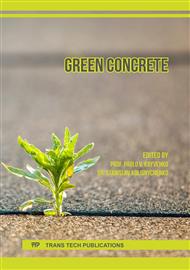p.27
p.32
p.40
p.45
p.55
p.61
p.66
p.71
p.77
Cracking Tendency of Self-Compacting Concrete Containing Crumb Rubber as Fine Aggregate
Abstract:
The utilization of crumb rubber particles extracted from waste tires in the production of self-compacting concrete (SCC) is a decent and sustainable solution to mitigate the impacts of such waste on environment. The aim of this study is to evaluate the cracking tendency of SCC with different content of crumb rubber extracted from waste tires. Five SCC mixtures were prepared. The reference mix was made with natural sand while the other four mixes were made with crumb rubber in which the natural sand was volumetrically replaced by crumb rubber at ratios of 10 %, 20 %, 30 % and 40 %, respectively. The results show that the addition of crumb rubber delays the cracking of concrete. The cracking time increases with the increase of the rubber content. The results also reveal that the addition of rubber particles not only increases the cracking time but also reduces the initial and final crack width.
Info:
Periodical:
Pages:
55-60
Citation:
Online since:
July 2017
Authors:
Price:
Сopyright:
© 2017 Trans Tech Publications Ltd. All Rights Reserved
Share:
Citation:



